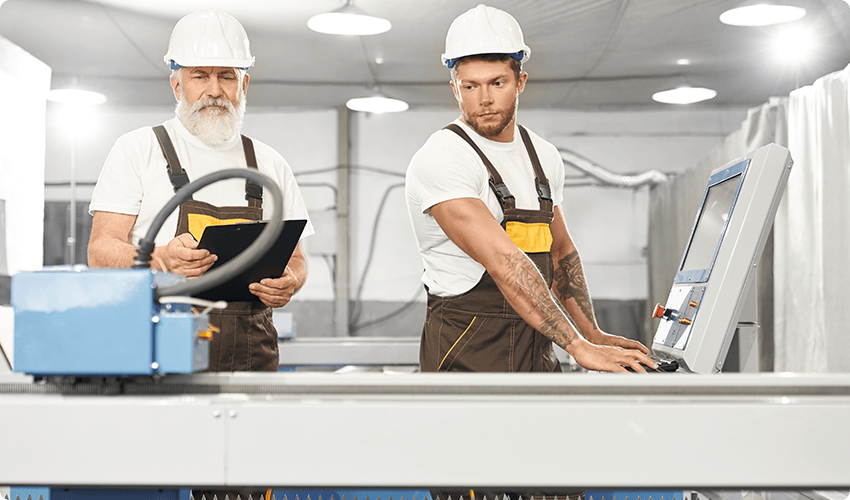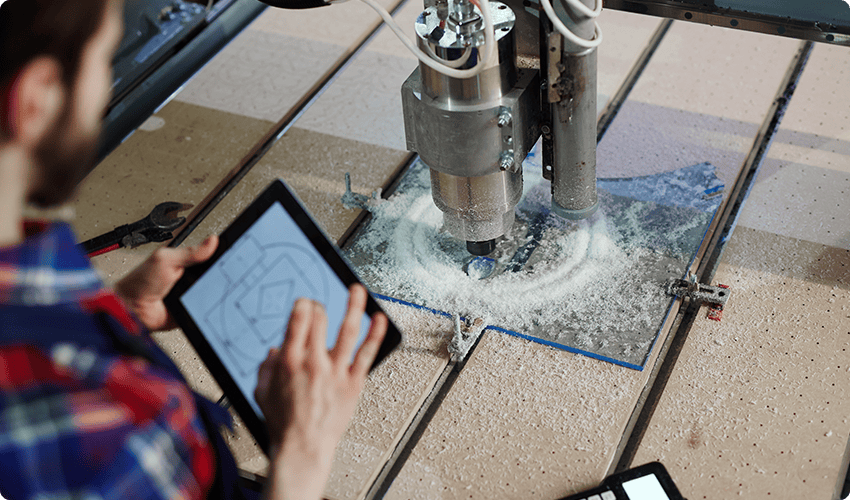
May 05, 2025 |
Waterjet Cutting Machine
Waterjet cutting is an innovative method of precisely cutting material using an extremely high-pressure jet of water mixed with abrasive particles. Compared to traditional cutting techniques, waterjet machines offer key advantages - no heat damage to the material, high precision, fast and automated operation, the ability to cut almost any material, and more.
In waterjet cutting, an intensifier pump capable of generating pressures up to 90,000 psi accelerates water through a nozzle made of ultrahard materials like sapphire or diamond at high speeds. Right before exiting the nozzle, abrasive substances like garnet or olivine sand are introduced into the high-velocity water stream. This abrasive-laced waterjet then cuts through the target material by eroding it away along precise paths directed by multi-axis machine systems.
Waterjet machines are highly versatile and adaptable automated cutting systems used across industries ranging from manufacturing to aerospace to artwork.
The Waterjet Cutting Machine utilizes the kinetic energy of an extremely high-pressure stream of water to cut through material. Intensifier pumps in waterjet systems use hydraulics to amplify water pressure from normal levels to up to 90,000 psi. High pressure water would flow through a tiny sapphire or diamond nozzle orifice itself without doing any cutting. This is where abrasives come into play.
The high-pressure water gets combined with abrasive substances like garnet, olivine or aluminum oxide through an abrasive inlet system right before the nozzle. The abrasives get injected into the water stream and accelerate to high speeds. The fast-flowing waterjet stream allows these abrasive particles to impact the target material with immense kinetic energy, thereby steadily eroding it away by cutting narrow channels into it.
Waterjet machines have five main components:
By precision directing of the abrasive Waterjet Technology stream across workpieces, automated multi-axis waterjets can cut intricate complex shapes rapidly and accurately through a wide array of materials.
There are two main varieties of waterjet cutting machines:
As the name suggests, these systems utilize a high pressure stream of just water without any abrasives added to it. Pure waterjets can cut softer materials like rubber, foam, and food items where the high-speed water stream alone provides sufficient cutting power.
The more common type of waterjet, abrasive waterjet, uses the kinetic impact provided by abrasive particles mixed into the high-pressure water stream to cut harder materials like metals, glass, stone, composites, plastics and more. The abrasives make these systems widely versatile across many applications.
There are also hybrid waterjet machines which combine high pressure waterjet cutting with other machining methods like laser, plasma or oxy-fuel cutting on the same work platform, offering additional flexibility.
Waterjet Technology provides distinct advantages that can benefit many cutting and machining applications across a diverse range of industries:
Materials cut using Water Jet Cutting:
Benefits:
Limitations:

Operating a Waterjet Systems requires expertise in aspects ranging from parameter selection and optimization, fixturing of workpieces, software programming, to monitoring consumable lifetimes. System operating pressure, abrasive flow rate, cutting speed and the nozzle height and angle need to be set precisely based on factors like material type and desired edge quality and tolerance.
To maintain performance and accuracy, waterjet machines require care and scheduled maintenance procedures:
Waterjet operators need proper training to expertly run these machines at peak efficiency while maintaining tight tolerances, optimizing cutting speeds based on the application, and minimizing overall operating costs.
The versatility, precision and reliability provided has led to waterjet cutting rapidly transitioning from niche to mainstream usage across a rising number of industries and applications. Automakers, aerospace companies, metal fabricators, manufacturers and more have been adopting waterjet equipment at increasing rates assisted also by their Class 1 safety ratings and green credentials.
Several technological upgrades and innovations have expanded waterjet capacities further:
The global waterjet cutting machine market has been projected to grow at over 8% CAGR over the next years as more end-user industries shift towards waterjet technology.
Driven by a high-pressure abrasive water stream capable of achieving extremely fine and fast precision cutting on virtually any material, waterjet cutting machines are transforming manufacturing and fabrication. With rising adoption across sectors buoyed by consistent innovations and advancements, waterjet systems offer automated, versatile and competitive precision cutting solutions to build a range of products.
The increasing popularity of Waterjet Solutions seems poised to develop further as businesses aim to enhance productivity, efficiency, quality and capabilities. More companies are realizing the advantages waterjets provide over incumbent technologies like laser or plasma cutting and making the switch. Integrations with automation, IoT and data analytics have also expanded the potential applications for both small job shops and large-scale operations.
Waterjet Cutting Machine, Waterjet Cutting Machine, Water Jet Cutter, Water Jet Application, Waterjet Cutting Machine Process, Water Jet, Waterjet, Waterjet Cutter, Water Cut, Water Cutting, Abrasive Jet, Cold Cutting Process, Waterjet Cutter Machine, Waterjet Cutting Machine Solutions, Waterjet Machines, Waterjet Solutions, Abrasive Waterjet, Waterjet Technology, Advanced Waterjet Technology, Abrasive Waterjet Cutting Machine, Waterjet Systems, Water Jet Cutting, Waterjet Mobile, Waterjet Machine, Cnc Controlled Portable Waterjet, Cnc Portable Waterjet Cut Pipe, Waterjet Cutting Machine Service, Water Jet Cutting Service
We provide innovative product solutions for sustainable progress. Our professional team works to increase productivity and cost effectiveness on the market.